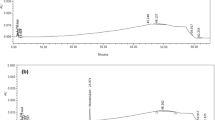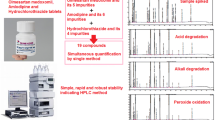Abstract
A novel and automated, stability-indicating, reversed phase ultra performance liquid chromatography (UPLC) method was developed and validated for the quantitative determination of erdosteine, its known impurities and two novel degradation products in a new pharmaceutical dosage form (effervescent tablets). The chromatographic separations were performed on a Waters Acquity UPLC HSS T3, 1.8 µm (2.1 mm × 150 mm, I.D.) stainless steel column. The mobile phase consisted of 0.1% TFA in water and methanol under gradient elution conditions, at a flow rate of 0.29 mL/min, for the assay and impurities analysis. UV detection was set at a wavelength of 238 nm. Erdosteine raw material, placebo and effervescent tablets were subjected to forced degradation. The new degradation products (labeled OX1 and OX2) were found after oxidative treatment and characterized by ultra performance liquid chromatography mass spectrometry. The validation parameters such as linearity, limit of detection (LOD) and quantification (LOQ), accuracy, precision, specificity and robustness were highly satisfactory for all analyzed compounds. LOD (0.020 and 0.011–0.385 µg/mL for erdosteine and impurities, respectively) and LOQ values show the high sensibility of the method. Specificity of the method was confirmed by testing the matrix components. The validated method demonstrated to be suitable for routine quality control purposes and for routine stability studies of erdosteine in effervescent formulations.




Similar content being viewed by others
References
Balsamo R, Lanata L, Egan CG (2010) Mucoactive drugs. Eur Respir Rev 19:127–133
Dal Negro RW, Visconti M, Turco P (2015) Efficacy of erdosteine 900 versus 600 mg/day in reducing oxidative stress in patients with COPD exacerbations: results of a double blind, placebo- controlled trial. Pulm Pharmacol Ther 33:47–51
Dal Negro RW, Visconti M, Micheletto C, Tognella S (2008) Changes in blood ROS, e-NO, and some pro-inflammatory mediators in bronchial secretions following erdosteine or placebo: a controlled study in current smokers with mild COPD. Pulm Pharmacol Ther 21:304–308
Dal Negro RW (2008) Erdosteine: antitussive and anti-inflammatory effects. Lung 186:S70–S73
Braga PC, Zuccotti T, Dal Sasso M (2001) Bacterial adhesiveness: effects of the SH metabolite of erdosteine (mucoactive drug) plus clarithromycin versus clarithromycin alone. Chemotherapy 47:208–214
Hosoe H, Kaise T, Ohmori K, Isohama Y, Kai H, Takahama K, Miyata T (1999) Mucolytic and antitussive effects of erdosteine. J Pharm Pharmacol 51:959–966
Martindale (2009) In: Sweetman SC (ed) The complete drug reference, 36 th edn. Pharmaceutical Press, London, p. 1560
Dhoka MV, Gawande VT, Joshi PP, Gandhi SV, Patil NG (2009) Simultaneous estimation of cefixime and erdosteine in bulk and pharmaceutical dosage form by spectrophotometric method. Hind Antibiot Bull 51:29–32
Nanda RK, Gaikwad J, Prakash A (2009) Spectrophotometric estimation of erdosteine in pharmaceutical dosage form. Int J PharmTech Res 1:492–495
Moustafa NM, Badawey AM, Lamie NT, El-Aziz ABD, El-Aleem ABD (2014) Stability-indicating methods for the determination of erdosteine in the presence of its acid degradation products. J AOAC Int 97:86–93
Khan Md MG, Jain PS, Shirkhedkar AA, Fursule RA, Kale NK, Surana SJ (2013) Stability indicating HPLC determination of erdosteine in bulk drug and pharmaceutical dosage form. J Pharm BioSci 3:105–109
Muramatsu N, Toyo’oka T, Yamaguchi K, Kobayashi S (1998) High-performance liquid chromatographic determination of erdosteine and its optical active metabolite utilizing a fluorescent chiral tagging reagent, R-(–)-4-(N,N-dimethylaminosulfonyl)-7-(3-aminopyrrolidin-1-yl)-2,1,3-benzoxadiazole. J Chromatogr B 719:177–189
Liu H. Wang B, Yaun G, Guo R (2007) RP-HPLC determination of erdosteine in human plasma and its pharmacokinetic studies. J Pharm Anal 27:1540–1543
Madhura VD, Vandana TG, Pranav PJ (2010) Simultaneous estimation of cefixime trihydrate and erdosteine in pharmaceutical dosage form by using reverse phase—high performance liquid chromatography. Int J ChemTech Res 2:79–87
Ayre AP, Pawar HA (2012) Stability-indicating RP-HPLC method for estimation of erdosteine and its degradation products in pharmaceutical dosage form. J Pharm Bioanal Science 1:2–7
Liu D, Wang Y, Tang Y, Chen X, Zhong D (2007) Quantification of erdosteine in the low-volume of dog plasma by liquid chromatography tandem mass spectrometry. Chem Res Chinese U 23:736–774
Kim H, Chang KY, Lee HJ, Han SB, Lee KR (2004) Sensitive determination of erdosteine in human plasma by use of automated 96-well solid phase extraction and LC–MS/MS. J Pharm Biomed Anal 34:661–669
Mhaske DV, Dhaneshwar SR (2007) High-performance thin-layer chromatographic method for determination of erdosteine in pharmaceutical dosage forms. Acta Chromatogr 19:170–184
Głowacki R, Bald E, Jakubowski H (2011) An on-column derivatization method for the determination of homocysteine-thiolactone and protein N-linked homocysteine. Amino Acids 41:187–194
Zinellu A, Sotgia S, Scanu B, Pisanu E, Sanna M, Sati S, Deiana L, Sengupta S, Carru C (2010) Determination of homocysteine thiolactone, reduced homocysteine, homocystine, homocysteine–cysteine mixed disulfide, cysteine and cystine in a reaction mixture by overimposed pressure/voltage capillary electrophoresis. Talanta 82:1281–1285
Chwatko G, Jakubowskia H (2005) The determination of homocysteine–thiolactone in human plasma. Anal Biochem 337:271–277
Daneshvar P, Yazdanpanah M, Cuthbert C, Cole DEC (2003) Quantitative assay of plasma homocysteine thiolactone by gas chromatography/mass spectrometry. Rapid Commun Mass Spectrom 17:358–362
Jakubowski H (2002) The determination of homocysteine-thiolactone in biological samples Anal. Biochem 308:112–119
Taleuzzaman M, Ali S, Gilani SJ, Imam SS, Hafeez A (2015) Ultra performance liquid chromatography (UPLC)—a review. Austin J Anal Pharm Chem 2:1056–1060
Kumar A, Saini G, Nair A, Sharma R (2012) UPLC: a preeminent technique in pharmaceutical analysis. Acta Pol Pharm Drug Res 69:371–380
Nováková L, Matysová L, Solich P (2006) Advantages of application of UPLC in pharmaceutical analysis. Talanta 68:908–918
Swartz ME (2005) UPLC™: an introduction and review. J Liq Chrom Rel Tech 28:1253–1263
http://www.chemspider.com (ID58798815)
Author information
Authors and Affiliations
Corresponding author
Ethics declarations
Conflict of Interest
The authors declared no conflict of interest.
Ethical Approval
This article does not contain any studies with human participants or animals performed by any of authors.
Informed Consent
This article does not contain any studies with human participants, so no informed consent was necessary for this study.
Electronic supplementary material
Below is the link to the electronic supplementary material.
Rights and permissions
About this article
Cite this article
Bertolini, T., Vicentini, L., Boschetti, S. et al. A Novel Ultra-High Performance Liquid Chromatography Method for the Determination of Erdosteine, Related Impurities and Degradation Products in New Effervescent Tablets. Chromatographia 81, 1661–1672 (2018). https://doi.org/10.1007/s10337-018-3636-8
Received:
Revised:
Accepted:
Published:
Issue Date:
DOI: https://doi.org/10.1007/s10337-018-3636-8




